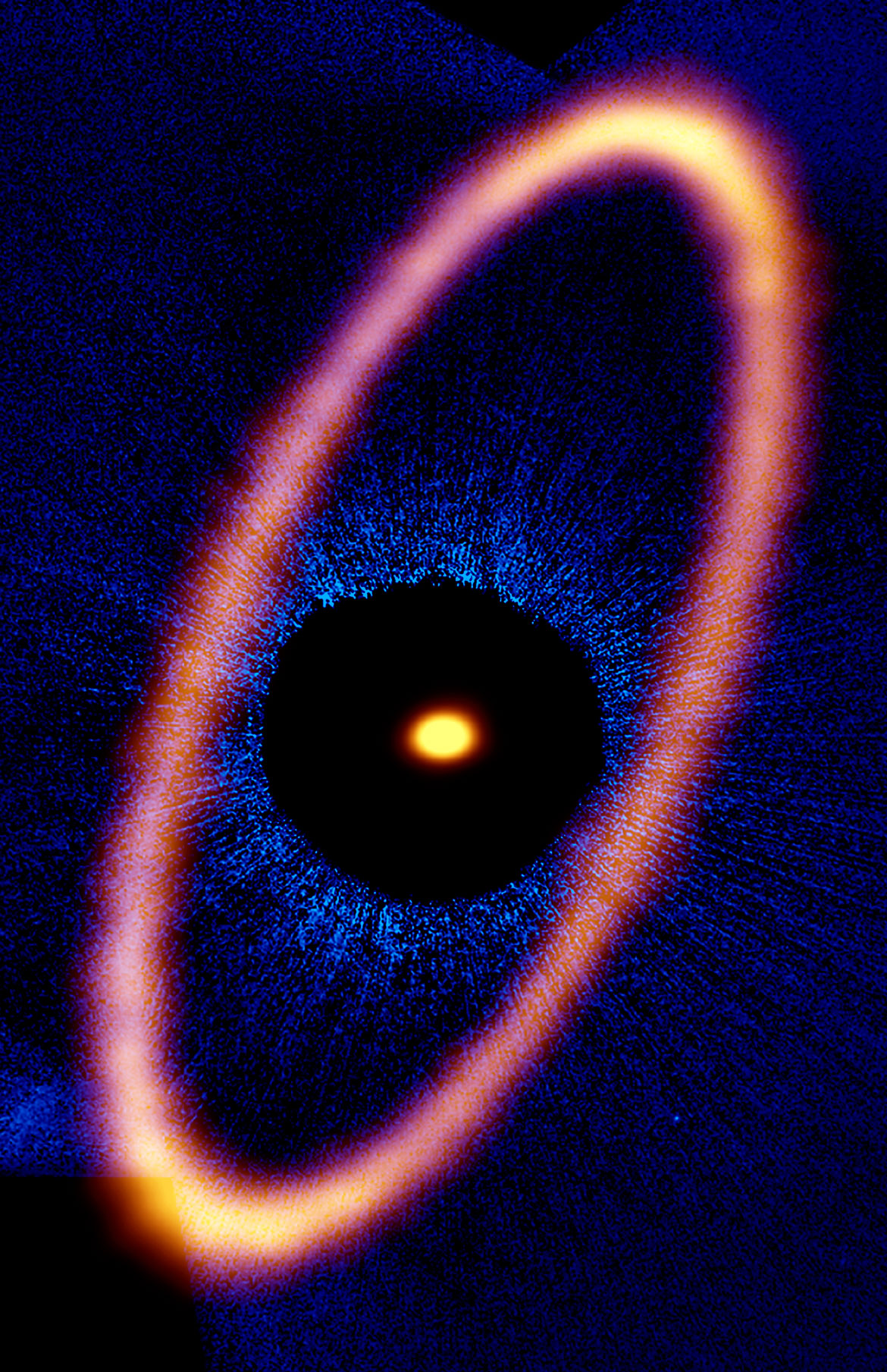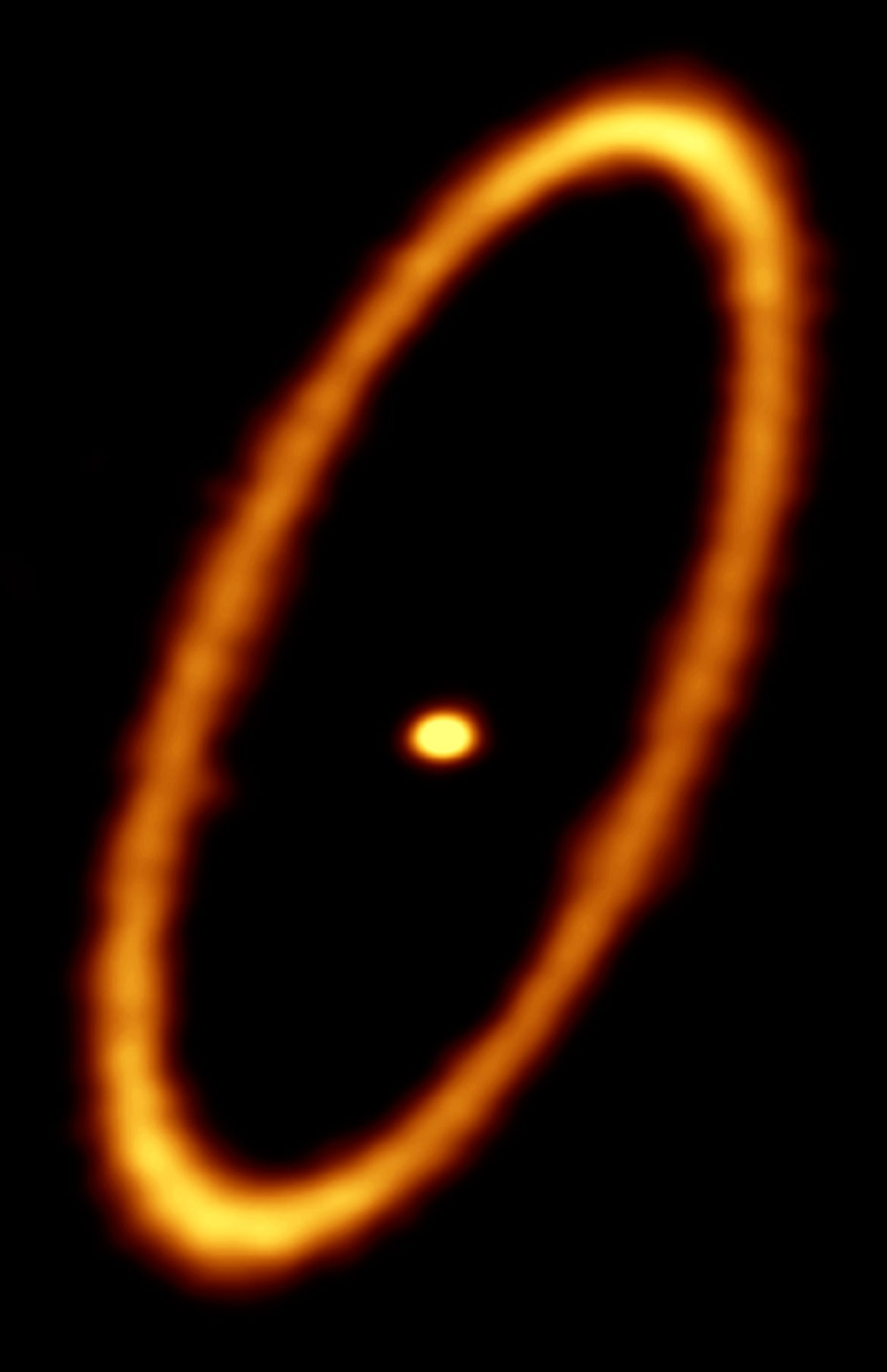Star's Comet-Like Icy Debris Ring Captured in New Video, Images
A ring of icy debris in a young, nearby planetary system resembles comets found in our own solar system, new images reveal.
The Atacama Large Millimeter/submillimeter Array (ALMA) recently captured the images, which show the debris disk in unprecedented detail.
The Fomalhaut system is located roughly 25 light-years from Earth, and is believed to be about 440 million years old — about one-tenth the age of our solar system. The belt of comet-like bodies surrounding Fomalhaut is similar to the Kuiper belt of icy objects beyond Neptune in our own solar system. [See Fomalhaut Star's Huge Ring of Dusty Debris | Video]
Though astronomers have known about a debris disk surrounding Fomalhaut since the 1980s, the recent images from the ALMA radio telescope array in Chile are the first to capture the disk in full and show that there may be chemical similarities between its icy debris and the comets found in our own solar system, according to a statement from the National Radio Astronomy Observatory (NRAO), a member of the international partnership that operates ALMA.
"ALMA has given us this staggeringly clear image of a fully formed debris disk," Meredith MacGregor, an astronomer at the Harvard-Smithsonian Center for Astrophysics in Cambridge, Massachusetts, said in the statement. "We can finally see the well-defined shape of the disk, which may tell us a great deal about the underlying planetary system responsible for its highly distinctive appearance."
Using the AMLA observations and computer modeling, astronomers measured the precise location, width and geometry of the debris disk. Their findings show that the eccentric ring of gas and dust lies about 12 billion miles (20 billion kilometers) from the star Fomalhaut and measures about 1.2 billion miles (2 billion km) wide.
The ALMA data also suggests that the narrow ring came from the gravitational pull of planets in the system, said MacGregor, who is the lead author of one of two papers detailing the ALMA observations. Both papers have been accepted for publication in The Astrophysical Journal.
Breaking space news, the latest updates on rocket launches, skywatching events and more!
Debris disks like the one found around Fomalhaut are often detected around young stars. The dust and gas in the disk absorb light from the central star and then re-radiate that light as a faint millimeter-wavelength glow, which the ALMA telescopes can detect.
What's more, the new ALMA data also shows the first known evidence supporting a phenomenon called "apocenter glow." This phenomenon explains why distant portions of the debris disk appear to be brighter. Dusty material traveling in an elongated, elliptical orbit around a star moves more slowly when it is farthest from the star and, as a result, piles up to form denser concentrations of debris that produce brighter emissions, according to the statement.
Comet kinship
In addition to showing more about the structure of the debris disk surrounding Fomalhaut, the ALMA observations reveal new clues about the nature of the star system. For example, the observations show vast amounts of carbon monoxide gas near the disk. The researchers said this gas could be the result of continuous comet collisions or one large impact between massive "supercomets," according to the statement.
"These data allowed us to determine that the relative abundance of carbon monoxide plus carbon dioxide around Fomalhaut is about the same as found in comets in our own solar system," Luca Matrà, lead author of the second paper and an astronomer at the University of Cambridge in England, said in the statement. "This chemical kinship may indicate a similarity in comet formation conditions between the outer reaches of this planetary system and our own."
But the similarities between this star system and Earth's solar system don't end there. The presence of a well-defined debris disk paired with the chemical familiarities detected in the outskirts of the star system suggest that the Fomalhaut system may be undergoing a comet bombardment similar to the one that occurred during a period in our solar system's history called the Late Heavy Bombardment.
During this era of our solar system's history, which occurred about 4 billion years ago, comets and asteroids pelted Earth and other planets. Now, the same could be happening in the young Fomalhaut planetary system, according to the statement.
"Twenty years ago, the best millimeter-wavelength telescopes gave the first fuzzy maps of ‘sand grains’ orbiting Fomalhaut," Paul Kalas, an astronomer at the University of California, Berkeley and principal investigator for the recent ALMA observations, said in the statement from the NRAO. "Now, with ALMA's full capabilities, the entire ring of material has been imaged. One day, we hope to detect the planets that influence the orbits of these ‘grains.’"
Follow Samantha Mathewson @Sam_Ashley13. Follow us @Spacedotcom, Facebook and Google+. Original article on Space.com.

Samantha Mathewson joined Space.com as an intern in the summer of 2016. She received a B.A. in Journalism and Environmental Science at the University of New Haven, in Connecticut. Previously, her work has been published in Nature World News. When not writing or reading about science, Samantha enjoys traveling to new places and taking photos! You can follow her on Twitter @Sam_Ashley13.


